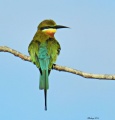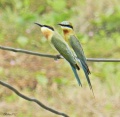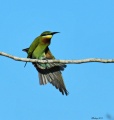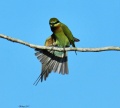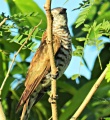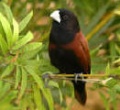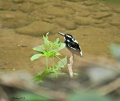LOG IN. UPLOAD PICTURES.
The Philippines has Zambo Mart to help propagate the Chavacano Language.
Category:Birds
Birds (class Aves) are feathered, winged, two-legged, warm-blooded, egg-laying vertebrates. Birds are characterised by feathers, a beak with no teeth, the laying of hard-shelled eggs, a high metabolic rate, a four-chambered heart, and a lightweight but strong skeleton. Birds have more or less developed wings; the only species without wings was the moa, which is generally considered to have become extinct in the 16th century. Wings are evolved forelimbs, and most bird species can fly. Flightless birds include ratites, penguins, and diverse endemic island species. Some species of birds, particularly penguins and members of the duck family, are adapted for swimming. Birds also have digestive and respiratory systems that are uniquely adapted for flight. Some birds, especially corvids and parrots, are among the most intelligent animals; several bird species make and use tools, and many social species pass on knowledge across generations, which is considered a form of culture.
Many species annually migrate great distances. Birds are social, communicating with visual signals, calls, and songs, and participating in such social behaviours as cooperative breeding and hunting, flocking, and mobbing of predators. The vast majority of bird species are socially monogamous, usually for one breeding season at a time, sometimes for years, but rarely for life. Other species have polygynous ("many females") or, rarely, polyandrous ("many males") breeding systems. Eggs are usually laid in a nest and incubated by the parents. Most birds have an extended period of parental care after hatching.
Many species are economically important. Domesticated and undomesticated birds (poultry and game) are important sources of eggs, meat, and feathers. Songbirds, parrots, and other species are popular as pets. Guano (bird excrement) is harvested for use as a fertilizer. Birds prominently figure throughout human culture. About 120–130 species have become extinct due to human activity since the 17th century, and hundreds more before then. Human activity threatens about 1,200 bird species with extinction, though efforts are underway to protect them. Recreational birdwatching is an important part of the ecotourism industry.
Aves ranks as the tetrapod class with the most living species, approximately ten thousand. Birds live worldwide and ranging in size from the 5 cm (2 in) bee hummingbird to the 2.75 m (9 ft) ostrich. The fossil record indicates that true birds first appeared during the Cretaceous period, around 100 million years ago. The current scientific consensus is that birds are theropod dinosaurs.
- This article copied verbatim from wikipedia
Subcategories
This category has the following 60 subcategories, out of 60 total.
B
C
P
W
Media in category "Birds"
The following 149 files are in this category, out of 149 total.
- Arctic warbler 1.jpg 720 × 540; 78 KB
- Arctic warbler.jpg 720 × 540; 69 KB
- Asian koel.jpg 720 × 540; 67 KB
- Black-faced coucal 1.jpg 720 × 540; 87 KB
- Black-naped oriole 1.jpg 800 × 600; 84 KB
- Black-naped oriole 10.jpg 720 × 540; 75 KB
- Black-naped oriole 2.jpg 800 × 600; 83 KB
- Black-naped oriole 3.jpg 720 × 540; 71 KB
- Black-naped oriole 4.jpg 720 × 540; 63 KB
- Black-naped oriole 5.jpg 720 × 705; 72 KB
- Black-naped oriole 6.jpg 720 × 540; 94 KB
- Black-naped oriole 7.jpg 720 × 540; 71 KB
- Black-naped oriole 8.jpg 720 × 540; 59 KB
- Black-naped oriole 9.jpg 720 × 540; 49 KB
- Black-naped oriole.jpg 800 × 600; 117 KB
- Black-winged stilt.jpg 800 × 600; 98 KB
- Blue rock thrush.jpg 720 × 540; 64 KB
- Blue-tailed bee-eater 1.jpg 800 × 600; 51 KB
- Blue-tailed bee-eater 10.jpg 800 × 600; 33 KB
- Blue-tailed bee-eater 11.jpg 800 × 600; 27 KB
- Blue-tailed bee-eater 13.jpg 843 × 883; 56 KB
- Blue-tailed bee-eater 14.jpg 720 × 797; 55 KB
- Blue-tailed bee-eater 16.jpg 843 × 821; 132 KB
- Blue-tailed bee-eater 2.jpg 800 × 600; 56 KB
- Blue-tailed bee-eater 3.jpg 800 × 600; 27 KB
- Blue-tailed bee-eater 4.jpg 800 × 600; 27 KB
- Blue-tailed bee-eater 5.jpg 843 × 884; 63 KB
- Blue-tailed bee-eater 6.jpg 800 × 720; 69 KB
- Blue-tailed bee-eater 7.jpg 800 × 600; 37 KB
- Blue-tailed bee-eater 8.jpg 800 × 600; 53 KB
- Blue-tailed bee-eater 9.jpg 800 × 600; 51 KB
- Blue-throated bee-eater 1.jpg 800 × 600; 48 KB
- Bright capped cisticola 2.jpg 960 × 720; 148 KB
- Bright capped cisticola.jpg 960 × 720; 147 KB
- Brown shrike.jpg 531 × 720; 67 KB
- Brown tit-babbler 1.jpg 843 × 812; 114 KB
- Brown tit-babbler 2.jpg 720 × 540; 99 KB
- Buff-spotted flameback.jpg 720 × 540; 89 KB
- Buzzing flowerpecker.jpg 720 × 540; 58 KB
- Cattle egret.jpg 720 × 540; 91 KB
- Clamorous reed warbler 1.jpg 800 × 600; 87 KB
- Coleto (Sarcops calvus).jpg 720 × 540; 74 KB
- Common greenshank 1.jpg 720 × 540; 87 KB
- Common greenshank.jpg 800 × 600; 70 KB
- Common moorhen.jpg 720 × 540; 94 KB
- Common redshank 1.jpg 800 × 600; 84 KB
- Common redshank 2.jpg 800 × 600; 85 KB
- Common sandpiper 1.jpg 800 × 600; 82 KB
- Dollarbird.jpg 720 × 540; 83 KB
- Grey heron 1.jpg 720 × 540; 65 KB
- Grey heron.jpg 720 × 540; 56 KB
- Grey-streaked flycatcher 1.jpg 720 × 888; 76 KB
- Grey-streaked flycatcher 2.jpg 800 × 600; 78 KB
- Grey-streaked flycatcher 3.jpg 720 × 540; 63 KB
- Grey-streaked flycatcher.jpg 800 × 600; 64 KB
- Guaiabero 1.jpg 720 × 540; 78 KB
- Guaiabero 2.jpg 720 × 540; 73 KB
- Guaiabero 3.jpg 720 × 540; 57 KB
- Guaiabero 4.jpg 960 × 720; 78 KB
- Guaiabero 5.jpg 720 × 551; 256 KB
- Little bronze cuckoo 1.jpg 720 × 540; 86 KB
- Little bronze cuckoo 2.jpg 960 × 720; 64 KB
- Little bronze cuckoo.jpg 843 × 923; 135 KB
- Little egret 1.jpg 720 × 540; 70 KB
- Little egret 2.jpg 720 × 540; 67 KB
- Little egret.jpg 720 × 540; 84 KB
- Long-tailed shrike.jpg 720 × 540; 63 KB
- Marsh sandpiper 1.jpg 960 × 720; 109 KB
- Marsh sandpiper 2.jpg 960 × 720; 96 KB
- Maya malacca.jpg 336 × 275; 25 KB
- Maya philippines01.jpg 131 × 120; 6 KB
- Mindanao hornbill.jpg 720 × 703; 85 KB
- Monkey eating6.jpg 584 × 800; 113 KB
- Monkey4.jpg 400 × 272; 23 KB
- Monkey5.jpg 180 × 180; 23 KB
- Olive-backed sunbird 1.jpg 800 × 600; 95 KB
- Olive-backed sunbird 2.jpg 632 × 720; 37 KB
- Olive-backed sunbird.jpg 800 × 600; 67 KB
- Orange-Tufted Spiderhunter 1.jpg 720 × 540; 67 KB
- Orange-Tufted Spiderhunter.jpg 720 × 540; 60 KB
- Palawan Peacock Pheasant - male.jpg 1,024 × 942; 607 KB
- Philippine coucal.jpg 720 × 540; 88 KB
- Philippine Eagle with nest.jpg 1,024 × 768; 586 KB
- Philippine magpie-robin 1.jpg 720 × 540; 94 KB
- Philippine magpie-robin 2.jpg 720 × 540; 112 KB
- Philippine magpie-robin 3.jpg 720 × 540; 113 KB
- Philippine magpie-robin.jpg 720 × 540; 92 KB
- Philippine serpent eagle.jpg 720 × 540; 58 KB
- Pink-necked green pigeon 1.jpg 720 × 540; 59 KB
- Pink-necked green pigeon 2.jpg 720 × 540; 78 KB
- Pink-necked green pigeon 3.jpg 720 × 540; 69 KB
- Pink-necked green pigeon.jpg 720 × 540; 53 KB
- Pink-necked Green Pigeon.jpg 1,024 × 725; 126 KB
- Pinsker's Hawk-Eagle 1.jpg 720 × 540; 126 KB
- Pinsker's Hawk-Eagle.jpg 720 × 540; 83 KB
- Polyplectron napoleonis-female-Lisbon.jpg 4,000 × 3,000; 5.25 MB
- Red-keeled flowerpecker.jpg 720 × 540; 50 KB
- Rufous Night Heron 1.jpg 800 × 600; 120 KB
- Rufous Night Heron 2.jpg 800 × 600; 78 KB
- Rufous Night Heron 3.jpg 720 × 540; 73 KB
- Rufous paradise flycatcher.jpg 720 × 540; 74 KB
- Rufous-fronted tailorbird 1.jpg 960 × 720; 103 KB
- Rufous-fronted tailorbird 2.jpg 960 × 720; 179 KB
- Rufous-fronted tailorbird 3.jpg 960 × 720; 204 KB
- Rufous-fronted tailorbird.jpg 960 × 720; 105 KB
- Scarlet minivet.jpg 720 × 540; 90 KB
- Southern Silvery Kingfisher 1.jpg 720 × 540; 57 KB
- Southern Silvery Kingfisher 2.jpg 720 × 540; 50 KB
- Southern Silvery Kingfisher 3.jpg 720 × 540; 51 KB
- Southern Silvery Kingfisher 4.jpg 720 × 540; 55 KB
- Southern Silvery Kingfisher 5.jpg 720 × 540; 55 KB
- Southern Silvery Kingfisher 6.jpg 720 × 540; 62 KB
- Southern Silvery Kingfisher.jpg 720 × 608; 47 KB
- Spotted dove.jpg 720 × 540; 57 KB
- Stork-billed kingfisher.jpg 720 × 540; 85 KB
- Striated heron.jpg 704 × 720; 127 KB
- Treron vernans -Tongkoko, North Sulawesi, Indonesia -pair-8.jpg 2,419 × 1,935; 305 KB
- Treron vernans.jpg 800 × 640; 149 KB
- Wallpaper (127).jpg 1,588 × 1,191; 339 KB
- White-breasted waterhen 1.jpg 800 × 600; 113 KB
- White-breasted waterhen 2.jpg 800 × 600; 97 KB
- White-breasted waterhen 3.jpg 960 × 720; 124 KB
- White-breasted woodswallow 1.jpg 960 × 720; 96 KB
- White-breasted woodswallow 2.jpg 960 × 720; 65 KB
- White-breasted woodswallow 3.jpg 720 × 540; 19 KB
- White-breasted woodswallow.jpg 720 × 540; 27 KB
- White-collared kingfisher 1.jpg 800 × 600; 122 KB
- White-collared kingfisher 2.jpg 800 × 600; 99 KB
- White-collared kingfisher 3.jpg 800 × 600; 98 KB
- White-collared kingfisher 4.jpg 720 × 540; 81 KB
- White-eared brown dove 1.jpg 800 × 600; 76 KB
- White-eared brown dove 2.jpg 800 × 600; 133 KB
- White-eared brown dove 3.jpg 720 × 540; 65 KB
- White-eared brown dove 4.jpg 720 × 540; 63 KB
- White-headed stilt 1.jpg 800 × 600; 85 KB
- White-headed stilt 2.jpg 800 × 600; 79 KB
- White-throated kingfisher 1.jpg 960 × 720; 50 KB
- White-throated kingfisher 2.jpg 960 × 720; 49 KB
- White-throated kingfisher 3.jpg 720 × 540; 81 KB
- White-throated kingfisher 4.jpg 720 × 540; 33 KB
- White-throated kingfisher 5.jpg 720 × 540; 33 KB
- White-throated kingfisher 6.jpg 918 × 960; 93 KB
- White-throated kingfisher.jpg 1,600 × 1,200; 872 KB
- Wood sandpiper 1.jpg 800 × 600; 99 KB
- Wood sandpiper.jpg 720 × 540; 75 KB
- Yellow bittern 1.jpg 800 × 600; 122 KB
- Zamboanga bulbul 1.jpg 800 × 600; 126 KB
- Zamboanga bulbul 2.jpg 960 × 720; 42 KB
- Zebra dove.jpg 720 × 540; 66 KB




















